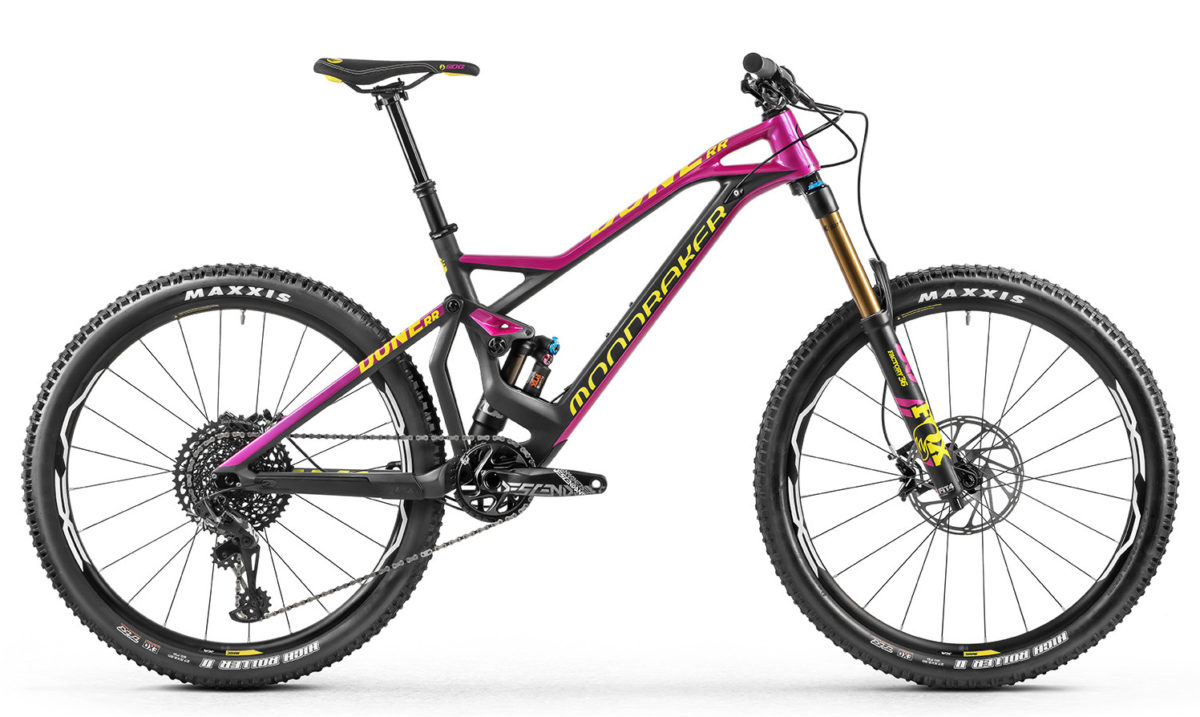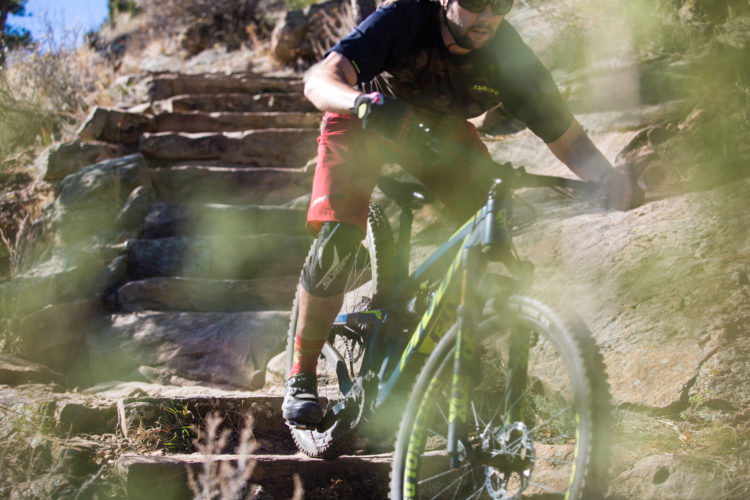
Some of the factors that engineers must consider when building a mountain bike include the frame material, suspension platform, wheel size, and components. But perhaps the most important aspect of any mountain bike is its geometry. The measurements for things like head tube angle, reach, chainstay length, and wheelbase have a bigger impact on how a bike rides than switching one brand of fork for another. Differences in geometry are what gives a bike its unique ride characteristics–hence the reason why seemingly-similar bikes feel very different out on the trail.
A while back I took a deep dive into comparing the geometry of modern trail bikes and more recently, I delved into the same topic for enduro bikes. The numbers referenced in this piece come directly from those two articles, so I encourage you to explore them as well.
The purpose of this particular article is to uncover the various differences between trail bikes and enduro bikes. What sets a trail bike and an enduro bike apart?
Enduro Bikes Have More Suspension Travel than Trail Bikes

If you’re well-versed in the different types of mountain bikes this may seem obvious, but it’s a key distinction for separating trail bikes from enduro bikes. The extra suspension travel lets riders go faster with a larger margin of error when choosing lines. In enduro racing where you’re often riding blind, a little extra squish can mean the difference between getting safely down the mountain or flying over the handlebars. Adding more suspension travel impacts the geometry too, as we’ll see later.
Based on my findings, the average 27.5″ trail bike has 142mm of suspension travel in the front and 135mm in the rear. Compare that to the average 27.5″ enduro bike with 166mm up front and 161mm out back. An average 27.5″ enduro bike has 24mm more fork travel and 25mm more rear shock travel.
The differences in suspension travel between the average 29″ trail bike and 29″ enduro bike are close to those of their smaller-wheeled brethren. Your average 29″ trail bike has 134mm and 123mm of travel front and rear, respectively, while an average 29″ enduro bike bumps that up to 158mm front and 152mm rear. Using those numbers, an average 29″ enduro bike has 24mm more suspension in the front and 29mm more in the rear.
Enduro Bikes Have Slacker Head Tube Angles than Trail Bikes

Holding all else equal, adding fork travel will slacken a bike’s head tube angle. However, that’s not the only way to create a slacker head tube. Designers choose a head tube angle for a particular suspension travel figure along with the bike’s intended purpose. A slack head tube angle pushes the front wheel further out ahead of the handlebars, increasing the wheelbase. The benefits of a slacker head tube angle include increased descending confidence and stability. There are drawbacks to a really slack head tube angle, though: they can make climbing difficult and make it tough to properly weight the front wheel in turns.
For both wheel sizes — 27.5″ and 29″ — my research shows that enduro bikes have head tube angles that are 2° slacker than their trail bike counterparts. A “mere” 2° may seem insignificant, but pair the slacker head tube angle with the additional travel and the result is a much more capable descender.
Enduro Bikes Have Higher Bottom Brackets than Trail Bikes

Generally speaking, the additional travel that enduro bikes carry raise the bottom bracket height. However, one must keep in mind that the listed bottom bracket height is a static measurement. This means the bottom bracket height doesn’t take into account factors like the weight of the rider and tire sag. A typical trail bike runs 25% sag on the rear shock and 20% on the fork. Enduro bikes require a higher sag percentage for optimal suspension performance, usually in the 30-35% range. Considering this, trail bikes and enduro bikes have very similar bottom bracket heights once a rider is aboard.
The average 27.5″ enduro bike has a bottom bracket that is 4mm higher than the average 27.5″ trail bike. For 29ers, the difference in bottom bracket heights is twice as much, with 29″ enduro bikes 8mm taller than a trail bike.
Enduro Bikes Have Longer Wheelbases than Trail Bikes

A bike’s wheelbase — the distance between the front and rear axles — gives you some idea of how stable it will be at speed. The longer the bike, the more stable it is. This is why downhill bikes have long wheelbases. With enduro bikes getting ever more travel and ever slacker head tube angles, it’s not uncommon to see their wheelbases approaching downhill bike length.
There are a few different ways to lengthen a bike’s wheelbase. Step one is to add more travel. Step two is to slacken the head tube angle. Step three is to lengthen the frame. Frame length can be increased at the chainstays, but these days it’s more likely additional length is added to the top tube. A longer top tube and the longer accompanying reach allow more room for the rider to move around while descending.
Wheelbase is where we see a big difference between trail and enduro bikes. The average 27.5″ enduro bike has a wheelbase 40mm longer than a 27.5″ trail bike, and 29″ enduro bikes are 43mm longer, on average. That’s a difference of over 1.5″ in length which has an enormous impact on handling.
Enduro Bikes Have Heavier-Duty Components than Trail Bikes

One of my favorite things about bikes is the ability to personalize them. Depending on how you ride and what kind of trails you ride, you’ll find that you prefer certain components over others. For instance, it’s possible to take a trail bike and build it up with enduro bike components for a bomber, but pedal-friendly ride. But, on the whole, enduro bikes use burlier components than trail bikes. Some of the differences in component selection between trail bikes and enduro bikes include:
- Wider handlebars
- Shorter stems
- Reinforced tires
- Tires with larger lugs
- Forks with larger stanchions
- Shocks with reservoirs
- Coil sprung suspension (front or rear)
- Wider, heavier rims (aluminum or carbon)
- Larger brakes (calipers and rotors)

Component manufacturers often offer various levels of their products tailored to a specific mountain bike discipline. Take Race Face as an example. They offer three different versions of their carbon fiber cranksets. The Next SL G4 are for cross country racing and light-duty trail riding. Stepping up from there is the Next R crankset which adds a little bit of weight but increases durability. Race Face rates the Next R cranks for all-mountain or enduro use. Finally, Race Face has the SixC crankset, which again adds weight, but ups the durability for use on downhill bikes. The point being, mountain bike product managers will select the appropriate component level for each bike within their range.
Wrap Up

Looking at just one single difference between trail bikes and enduro bikes doesn’t provide the proper context. It’s only once all of the various geometry and component changes are added together that the resulting bike provides a substantially different ride quality and capability.
As mentioned in my companion articles, it seems unlikely we’ll see the same drastic changes in mountain bike geometry over the next five years as we did the previous five years… unless there’s some new radical suspension platform or frame design on the horizon, of course. Until that happens, companies will continue to tweak their current geometry formulas in an attempt to eke the most performance out of a given model.





















2 Comments
Mar 1, 2018
Aug 28, 2018